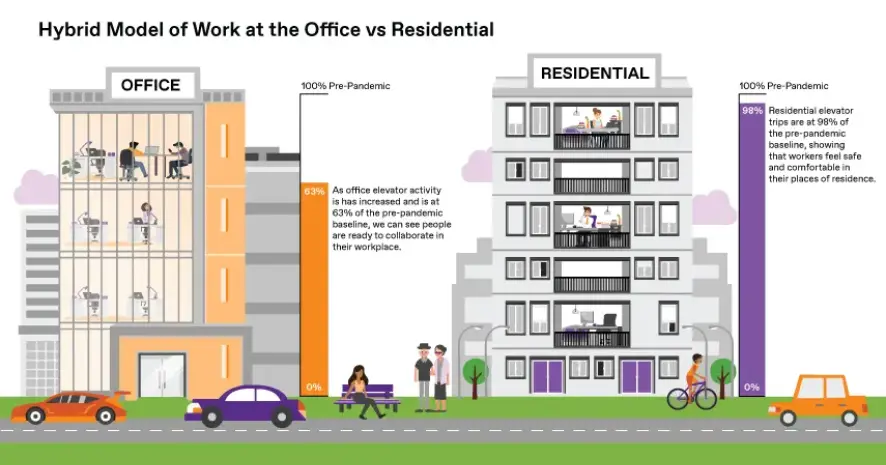Hybrid Work Schedule: How Elevator Activity Reveals the Future of Working from Home
From sharing new ideas with colleagues to appreciation for a tidy desk or even opening a new pack of dry erase markers—there’s a lot that we’ve all missed about working in an office.
Thankfully, elevator data in the TK Elevator Index Report has proven that workers are making their long-awaited return to the office. Not only has the TKE Index Report given us insight into the volume of commuters going into their offices but also how they move through their buildings and when they leave for their homes. Through this data, we were able to identify the things that help tenants feel comfortable entering their place of work.
What elevator trip activity can tell us about when and where people work
When a day-by-day data comparison was done between office buildings and residential buildings, a pattern revealed itself. On days that residential building activity was low, office building activity was high. Similarly, on days that office building activity was low, residential building activity was high.

This data essentially confirms that the hybrid model is in use across America for office workers.
Hybrid working became increasingly popular with the advancement of telework technology. The hybrid model is a method of work where an employee can split their time between their office and their place of residence should they choose to. At the beginning of the pandemic, offices began to find this model extremely helpful in keeping workplaces running efficiently.
While there is currently a great health benefit to working from home, there is also an undeniable advantage to being in the office. Thus, the hybrid model has become the norm for many offices across North America.
While they enjoy working from home some days, office workers and tenants still commute to work in the office as well. This could be a positive sign illustrating that workers feel more relaxed going to the office now so they can collaborate openly with their colleagues.
The ability to continue to build work relationships and network face-to-face is a luxury that many have missed during the start of 2020. This being said, it’s of the utmost importance that workers feel secure amidst the pandemic. Now that technology is advancing rapidly to meet the growing needs of a hybrid work-from-home society, we can recognize that building managers must continue to find innovative methods to keeping their tenants safe. That all starts with the backbone of any building: the elevator.
But what are some ways that building managers can go above and beyond to help their tenants feel at ease with their elevators?
Recently, we have laid out several of the latest trends which have taken the elevator industry by storm.
- Touchless technology means tenants never need to touch a button in order to call their elevator. This technology lessens the likelihood of transmitting a virus.
- Intelligent Dispatching will have an elevator ready for the tenant, ensuring that waiting areas stay free from congestion and social distancing is still possible.
- 5G Technology allows for insight and predictive maintenance which lowers the likelihood of an elevator being out of service, thus reducing tenant complaints.

These three and other trends are at the forefront of elevator technology, working to create better years ahead for everyone. Hybrid working from home may be here to stay, but implementing these technologies will put workers at ease so that they can frequently experience open collaboration and creativity with their colleagues in the office.
 United States
United States

